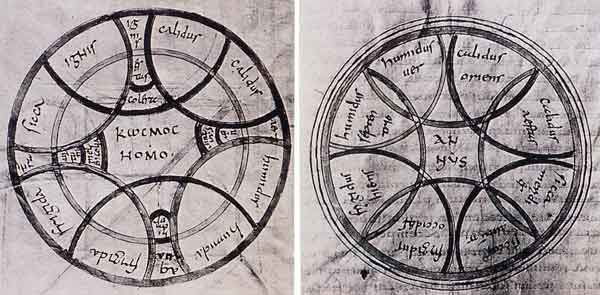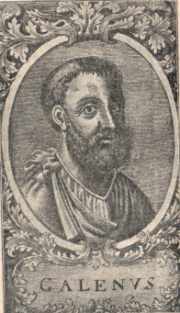GALEN'S MIXTURES:
"Dogs are drier, men are wetter."
Dr. Peter Vronsky

Geometric vector modeling of elemental mixture theory.
From Isidore de Seville, De natura rerum,
manuscript circa A.D. 800
(IMAGE SOURCE: Cologne Diocese Library, Germany)
GALEN'S MIXTURES:
WHY "DOGS ARE DRIER, MEN ARE WETTER."
(537)
Galen states that animal bodies are an unequal “mixture”
of hot, cold, wet, and dry—an elaboration of the
Hippocratic Pythagorean concept that the cosmos consists of four
geometrically interacting primary life elements: earth, air,
water, and fire. (509)
These mixtures can become "ill balanced" and these imbalances
can be vectored in various configurations. Mixtures also define
and measure objects, qualities, and other subjects, such as climate for
example.
TERMS OF REFERENCE
The terms--hot, cold, wet, or dry--are not always absolute
nor used in the same way, Galen notes. They can be used in three different senses,
depending on the circumstance, context and subject: 1) in the absolute
sense;
2) median based; and 3) comparative. Only the latter two
are applicable to mixture theory:
In the absolute sense, only primary elements and their derivatives can be intrinsically hot, cold, wet, or dry (water is wet; fire is hot; etc.) Mixture theory, therefore, is not applicable to describing primary elements because their quality is self-contained. (539)
In the context of mixture theory, however, the terms are not
absolute:
In the
median based models, such terms “derive rather
from an excess of any one of these qualities in the mixture. We say that a body is wet when its share of wetness is larger…”
(510) "When we use the term to indicate a predominance of that
quality in an object which is a mixture of opposites." (539)
The degree of imbalance is measured against a predefined median state for a particular
species or genus. (550) "A term is applied to something by
reference to its genus or species when it has the quality denoted by that term
to a degree greater that the median." (540)
The ability to accurately recognize and define that median, according to Galen, is the basis of knowledge and expertise in medical science. (560)
The terms can also be applied in the comparative sense between species and within genus--"dogs are drier, men are wetter." The quality of wet, dry, hot, or cold, in a subject can depend upon what it is being compared to. Dogs while drier than men, are wetter than bees. (541) Diagnostic criteria are likewise relative when defining the parameters of a healthy median mixture balance. For example, intelligence is more valued in a man, while ferocity and docility is sought in a dog, only ferocity in a lion, (566) Galen draws a comparison with the concept of justice: "a technique of finding equality not by any fixed measure, but by use of the criteria appropriate to the case." (548)
MIXTURE TYPES
(Simple Mixtures Imbalances)
wet / dry
-------------------------------------------
hot / cold
On a basic level there are four "simple" mixture imbalances configured across two sets of "oppositions": hot-cold and dry-wet.
There are an additional four out of six theoretically possible "inclined" or "composite" mixtures imbalances: hot-wet; hot-dry; cold-wet; cold-dry. The remaining two, hot-cold and wet-dry, logically are impossible. (518) These four composite mixtures "have a position halfway between the well-balanced state and those states which are ill balanced in virtue of both oppositions." (556-559) There is an "inclination to one side or the other in both of the two oppositions." (573)
(Inclined Composite Imbalances)
wet-cold / exist / dry-hot
----------------------/---------------------
wet-hot / disputed / dry-cold
According to Galen, the existence of hot-wet and cold-dry mixtures was at the time disputed by some. It was thought that heat “uses up” moisture, while cold was unable to “digest” moisture. Galen, argues however, that others do not accept the premise that moisture is destroyed by the domination of heat. Moreover, they argue that a hot-wet state can exist as a starting point during a transition to an eventual dry state, and vise versa. (Boiling water evaporates from hot-wet to hot-dry states...) (511-518)
( Varied Inclinations in Composite
Mixture Imbalances)
WET
DRY
wet-cold [wet-hot/cold] /
dry-hot [dry-hot/cold]
/
-------------------------[ perfect balance ]
------------------------
/
[wet/dry-hot] wet-hot /
[wet/dry-cold] dry-cold
HOT
COLD
Claudius Galen
(Claudius Galenus;
Klaudios Galenos)
born: Pergamum, A.D. 131
died: Rome,
circa 216
· Began his study of medicine around the age of sixteen in Smyrna and Corinth.
· Continued his studies in Alexandria where he might have studied anatomy with the aid of autopsies in 152-157. (“…look at the human skeleton with your own eyes. This is very easy in Alexandria, as the physicians of that area instruct their pupils with the aid of autopsy" (Kühn II, 220, translation L. Edelstein).
· 157 Galen returned to Pergamum where he was appointed doctor to the gymnasium attached to the local sanctuary of Asklepios.
· 162 Galen went to Rome where he taught and served as surgeon to gladiators. (Other versions of his biography state he treated gladiators in Pergamum upon his return from Alexandria.) In Rome he became renowned and found himself entangled in Roman medical community politics and had to leave in 166, remaining in obscurity for several years.
· 168 recalled by the Roman Emperors Marcus Aurelius and Lucius Verus to serve in the army as a surgeon in the war against the Germans
· After returning to Rome, Galen served as a physician to the elite, including the Marcus Aurelius and Aurelius' son, Commodus
· Research by Vivian Nutton, based on Byzantine and Arab scholars from the sixth century, has persuasively set the date of Galen's death around 216, much later than previously held.
· Exercised a dominant influence on medical theory and practice in Europe from the Middle Ages until the mid-17th century.
· Three hundred titles of works by him are known, of which about 150 survive wholly or in part. The Kühn edition of Galen (Greek with a Latin translation) runs over 20,000 pages (Kühn, C.G. Galeni Opera Omnia. Leipzig: C. Nobloch, 1821-1833, rpt. Hildesheim, 1965.) There are other Galenic works that only exist in Arabic translations.
· The terms "galenic" or "galenicals" is still used to describe drugs and medicaments made directly from vegetable, mineral or animal ingredients (known as "simplicia") using prescribed methods. In all he described 473 drugs of animal, vegetable or mineral origin as well as his own formulae.

Galen
Source Links |
Galen adds that he departs from other physicians of his time in his assertion that there exists a fifth independent state: the well-balanced mixture--the healthy state. (519)
There are, therefore, in Galen’s model, nine states of mixture: four simple imbalances, four inclined composites, and a state of perfect balance--healthy. For humans, Galen describes this state as represented by the "well-fleshed man", who is neither fat nor thin, dry nor wet, and subject to a definition of median optimum health. (559) (541)
STANDARDS FOR DETERMINING BALANCE AND MEDIAN
Since the ability to understand median qualities in a variety of subjects and circumstances is the key to
effective technique in medical science, a series of diagnostic criteria define a median for various subjects.
"One who wishes to gain expertise in the identification of mixtures
should begin his training with the well-balanced, median types within each
genus. Using these as his yardstick he will easily discover what
is excessive or deficient in each case." (560)
Galen elaborates on the comparative model of the ideal median mixture balance, pointing out that it is not based on an equality between the four terms--but on "appropriateness of these amounts to nature of the animal or plant in question." (548)
Galen outlines an experimental and learning methodology for mixtures by describing how one arrives at the medium state for a subject's mixture: "We begin with the hottest of all perceptible things, fire, say, or violently boiling water, and draw a line from that down to the coldest substance we know, ice, say, or snow; and we mark this line exactly in the middle. This will give us the point of good proportion conceptually--that which is equidistant from each of the extremes."
(561)
Finally Galen concludes that a total mixture of one with the other--of, hot, cold, dry, and wet--is "not humanly possible to achieve."
It is only possible for "God, and in Nature, especially in the case of mixture of hot and cold."
It is, however, according to Galen, possible to humanly create illusionary states "that will appear to you well balanced..."
He explains, "when one mixes earth with moisture, this creates the illusion of a total mixture of the two substances; but what takes place in reality is a placing alongside each other of very small parts, not a total mixture." (Atomic particle theory?)
(563)
